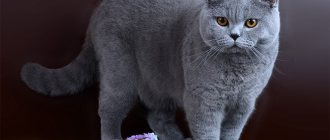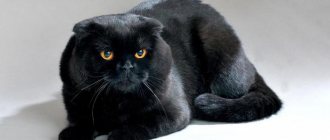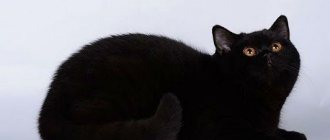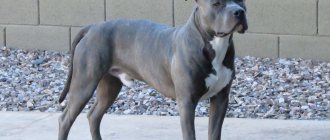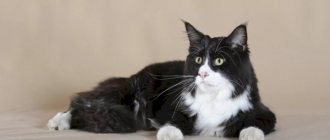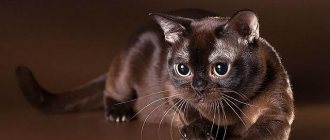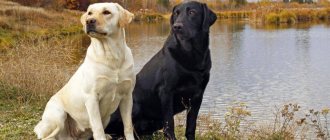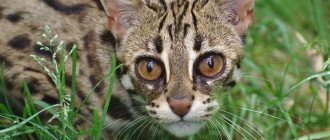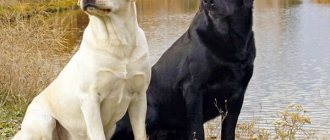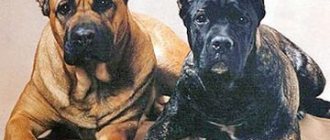According to the classification adopted by the Fédération Cynologique Internationale (FCI), Labradors are classified in the VIII breed group of Retrievers. The full name of the breed is Labrador Retriever.
In addition to Labrador, the group includes 5 more breeds - Nova Scotia, straight- and curly-haired, golden (golden) and Chesapeake Bay retrievers.
The name “retriever” (in English “retriever” - the one who returns, brings) indicates the specialization of dogs. All of them were bred for gun hunting, their main purpose is to find and bring back shot undamaged game.
All dogs in the group have high intelligence, good trainability, good disposition and universal working qualities.
Types of Retrievers
The retriever group includes six different breeds:
- Labrador Retriever
- Golden retriever
- Flat-Coated Retriever
- Curly coated retriever
- Nova Scotia Retriever
- Chesapeake Bay Retriever
Chesapeake Bay Retriever
Golden retriever
Curly coated retriever
Labrador Retriever
Nova Scotia Retriever
Flat-Coated Retriever
These are all hunting dogs that were bred so that they could find prey and bring it to the hunter. Primarily waterfowl. They are all similar, but, nevertheless, they are different breeds.
Golden or golden
One of the smartest breeds in the world, the record holder for the loudest bark (more than 113 decibels), a popular and fashionable pet in the USA and Europe. Golden Retrievers appeared in the late 19th century in Great Britain. Their close relatives are Irish Setters, Newfoundlands, Labradors and Collies.
The breed was officially recognized only in 1913 and since then has been used for various purposes: service in the army, rescue squads, clinics. Retrievers bark loudly and have a territorial instinct, but are not good as guard dogs because they are kind to people and other animals.
Medium-sized dog: up to 56 cm at the withers and 40 kg in weight. The body is strong, muscular, square in format with a sloping topline. The head is round, with a pronounced stop and a square muzzle. A unique difference is the long, wavy, silky coat of a golden or cream shade. Yellow or white color is considered defective.
This is a cheerful, kind dog with good physical and working qualities. The animals are calm, balanced, but playful and active. They are great with children, but require constant physical activity and proper upbringing.
Dogs have developed intelligence, they respond to any training program, quickly remember commands and love to serve their owner. The average cost of a puppy of this breed is 25,000 rubles.
Brief history of the breed
The ancestor of Labradors is the St. John's Water Dog, originally from the island of Newfoundland (now Canada). She was popular with fishermen and helped them pull nets out of the water, she was very efficient, swam well in the water and was not afraid of the cold.
It was imported to England, where, thanks to its working qualities, it took root and became popular.
- In 1903, the Labrador Retriever breed was officially registered with the English Kennel Club.
- In America the breed was recognized a little later in 1917
Until a certain time, there were no differences between English and American dogs. But due to the difference in the qualities required of them, and the different approach to breeding in America and England, the dogs began to differ in appearance and temperament.
Curly-Coated (Curly-Coated)
This Retriever is different from his brothers. The breed is the rarest of the group and the most non-contact. It began to be bred at the beginning of the 19th century on the island of Newfoundland. Curley's ancestors: Irish Spaniel, Newfoundland, Setter, Poodle.
At first, dogs served fishermen and helped on ships until aristocrats noticed them. Breeders decided to improve hunting qualities and got a discreet, strong Retriever
Since 1860 the animals have been kept as pets and hunting dogs . Since the 20th century, the breed was brought to Australia and New Zealand, where Curly-Coated Terriers are now popular, unlike Russia and other Eurasian countries.
Retrievers are standard in format: an elongated rectangular body, dry limbs, a square muzzle and a round head. Their fur can be brown or reddish in color, and is curled into tight strands.
This is an intelligent and strong working dog that is ready to train and serve people faithfully. She does not show aggression, but does not like the pranks of children and is wary of strangers. Curleys need the owner's firm hand, leadership, and good upbringing. Otherwise, in a circle of people, the Retriever will be embarrassed, lost, and angry.
Features of English and American Labradors
Show (left) and field Labrador (right)
Here is what the American Labrador Retriever Club, officially recognized by the AKC, writes about this: There is one breed of dog known as the Labrador Retriever, and the requirements for it are clearly described in the breed standard.
However, there may be differences in body structure within a breed, as dogs have evolved to suit the preferences of individual breeders and owners. In the United States, people mistakenly began to call them English or American. Perhaps a better description is "show/show breeding" or "working/field Labrador".
A working/field or "American" style dog is a Labrador retriever that has a lighter bone structure, longer paws, less dense hair, a narrower head with a longer muzzle. They are bred for hunting, sport and work, so they are slimmer and more athletic.
The show/show breeding or "English" Labrador is typically stocky, large-boned, has a large, barrel-shaped chest, shorter legs, a thick coat, and a head that is often described as "square or blocky." They are mainly bred for exhibitions, sometimes for hunting game. However, they have no differences in weight.
However, working/field dog species are also found in England.
Appearance does not help determine a dog's temperament, trainability, or health. In fact, the vast majority of Labradors, regardless of conformation, have a body type very close to the breed standard.
Moreover, even puppies from the same litter can differ in body type. Therefore, details of external differences, differences in temperament, health and pedigree of the dog's origin must be discussed with the breeder.
If we directly compare the standards of FCI (RKF) or Russian, AKC (American), UKC (English), then we can find some minor differences, but as a rule no one pays attention to them and dogs are divided only by coat color. The links provide official standards in pdf format.
Accepted standard
There are three breed standards :
- English;
- American;
- FCI.
At exhibitions and trials, a dog is judged only according to the standard specified in the pedigree. In Russia, most Labradors originate from kennels that adhere to FCI standards published in 1987.
FCI Labrador Retriever Standard:
| Characteristics | Description | Notes |
| Application | Gun dog | — |
| Group | water dogs, spaniels, retrievers | — |
| Section | retrievers | — |
| Tests | With working tests | — |
| General impression | Active dogs of strong build with strong bones, compact format, with a voluminous chest and developed ribs, powerful hind legs, croup and loin. | Dogs with a dry body type are not welcome. The croup is not sloping towards the tail. |
| Scull | Wide, with pronounced stop lines and transition from forehead to muzzle. | The cheeks should not be fleshy and the muzzle should not be pointed. |
| Nose | The lobe is large. The nostrils are well defined. | Lack of pigmentation is considered a defect. |
| Jaws | Strong, round, “soft”. | — |
| Bite | Scissor-shaped | — |
| Teeth | Medium in size | Only the American standard specifies a complete set of teeth |
| Eyes | Expressive, intelligent, medium-sized, brown or hazel (yellow possible) | American standard allows black eye color |
| Ears | Small, hanging, not weighted, low seating, far back | The ears fit rather closely to the skull |
| Neck | Strong, with well-developed muscles and beautiful lines, not loaded, medium in length | — |
| Back | Rovnaya | — |
| Shoulders | Set obliquely, long | — |
| Tail | Thick at the base, medium in length, tapering towards the end, round - “otter”. The coat is dense, rough, and short. The tail is allowed to be slightly raised. | A distinctive feature of the breed. Should not be bent towards the back like a sickle |
| Forelegs | Straight, parallel. The length is equal to half the height at the withers. The hock joints are pronounced. Closely placed joints are classified as disadvantages. | “Cow” (too wide or narrow) position of the limbs is undesirable |
| Paws | Round, gathered into a ball. Pads are firm, developed | — |
| Movements | Free, economical | — |
| Wool | Short, thick, hard, straight. The undercoat is water-repellent and dense. | Wavy, curly, excessive length are not allowed |
| Height at withers | Males 56-57 cm, females 54-56 cm. | American standard - males 57-62 cm, females 55-59 cm. |
IMPORTANT!
None of the standards indicate the weight of the dog. The main thing is that the constitution corresponds to the general description. FCI recommends sticking to 27-40 kg.
Officially recognized Labrador color types
There are three officially recognized primary colors: black, yellow and chocolate.
- Black Labradors are usually completely black or with a white spot.
- Yellow Labradors can range from pale yellow to almost red in color.
- Chocolate - from light brown to dark.
Three officially recognized colors: brown, fawn and black.
The gene that is responsible for the black color is more dominant than the others and initially black dogs were the most common.
Regardless of appearance, they are loyal, energetic dogs who love their owner. They have high intelligence, are easy to train, love attention, and are known to be even-tempered. They love to bark, but they usually don’t make good watchdogs, as they want to be friends with everyone. They make good walking companions, enjoy physical activity, and love to swim.
Labradors are often called ideal family pets because they are gentle, caring and very friendly dogs. You will never have to worry about these dogs being friendly with small children or strangers, but they are also not afraid to stand up to a threat and protect you if the need arises. Thanks to these qualities, Labrador retrievers have gained wide popularity.
Some Labrador owners are convinced that the color of the coat affects its temperament. It’s as if yellow Labradors are the calmest, chocolate Labradors are wild and violent, and black Labradors are the most patient hunters. Many studies have been done to find any patterns and evidence of this. But they were never found.
Coat color is determined by two genes that have nothing to do with character. One of the genes determines whether the coat will be light or dark, and the other, chocolate or black. In fact, it is quite common for Labradors to have puppies of different colors in their litters.
Silver wool
It would be wrong not to tell you about one more color, although it is not recognized by modern standards.
In the middle of the 20th century, one hunting publication in America placed an advertisement for the sale of gray Labrador puppies. Emphasis was placed on the rarity of this color, which supposedly increased its value. This, of course, can be considered a regular advertising gimmick. And yet the silvery coat of such puppies is magnificent and will become a real treasure for a loving owner.
The only negative is that you cannot enter the ring and participate in exhibitions. But maybe just for now? Who knows, maybe the time will come when experts will recognize “silver” as the fourth standard color for Labrador?
The development of gray shades continues. “Coal” and “champagne” already exist. True, the first is considered a lighter shade of black, and the second is considered fawn. “Silver” itself is a lightened brown color. And there is a version that a completely different breed of dog is involved here - Weimaraners, which have exactly these coat colors.
All colors are considered non-standard if they have any inclusions called “splashes”. But any of these dogs can become your loyal friend. And it is not at all necessary to win exhibitions. The dog itself doesn’t care about this, and its owner will in any case get a lot of pleasure from communicating with his pet.
Genes responsible for the black and brown color of a dog
The information that determines whether a Labrador will be black or chocolate is passed on through a pair of genes:
- One of them is the large B gene (this is the dominant gene), which causes black fur.
- There is also a small b (this is a recessive gene) that causes a brown or chocolate coat.
This leaves three different combinations of genes that a Labrador can inherit from its parents (one from each):
- BB
- Bb
- bb
Why is black the most common color? Because gene B, which is responsible for this color, is dominant. It is normal for dominant genes to turn off or ignore recessive genes.
- A dog with BB genes will be black because it does not have the small b gene that produces brown fur.
- A dog with Bb genes will also be black because if the dominant black gene is present, it will turn off the recessive one.
- Accordingly, only an individual with bb genes will be chocolate.
More clearly
Generation after generation of black Labradors can give birth to black puppies
One gene is taken from each parent's dog
Until two individuals with a small b gene meet
In case of bb genes the dog is chocolate colored
Genes responsible for the yellow color of a dog
But, there are times when a dog with the BB or Bb genes will not be black. And when a dog with bb genes will not be brown. There is another pair of genes that is responsible for the yellow color. Genes E and e. Accordingly, also dominant and recessive.
These genes have a different power. They have power over the B and b genes and can displace black and chocolate. Its small genes are able to influence or, in some cases, “turn off” the B and b genes.
- Large gene E (dominant), does not affect color.
- The small e gene (recessive) can mask or turn off the B and b genes, which would otherwise give us black or brown coloration. But this is only true if there is no dominant gene E, as we discussed above, it turns off the recessive gene.
Each individual inherits one of these genes, resulting in three possible combinations:
- E.E.
- her
- Ee
Only in the case of ee genes will the Labrador be yellow.
It turns out that we have three pairs of genes:
- E.E.
- her
- Ee
- BB
- Bb
- bb
Varieties of genotypes
The table below lists the possible varieties of genotype and phenotype (genotype is a set of genes, phenotype is appearance).
| Gene set | Color |
| EEBB | Black |
| EEBb | Black |
| EEbb | Brown |
| EeeBB | Black |
| EeBb | Black |
| Eebb | Brown |
| eeBB | Yellow |
| eeBb | Yellow |
| eebb | Yellow |
Breed genetics more clearly
Genes responsible for the silver color of a dog
But that is not all. There is another pair of genes, D and d. These genes have the ability to suppress all other colors, albeit in a subtle way.
This leaves three more options:
- DD
- Dd
- dd
When two small dd genes come together, they "dilute" the Labrador's coat color.
Labrador with silver wool
If the dog is black, the coat will be a soft charcoal color; a yellow dog will have a paler, champagne-colored coat. For a chocolate cat, the result of this mixture will be silver wool. This color is not officially recognized, as there is debate about purebredness.
Straight-haired (Flat-Coadet)
Flat retrievers are actively gaining popularity, trying to catch up with Labradors. The dogs were bred in Britain at the end of the 18th century, but the breed was finally formed in the mid-19th century.
Like their brothers, Flats are waterfowl hunters. At first, the animals worked together with the Spaniels, catching birds, but later they only began to bring shot prey.
The first individuals had wavy hair; at exhibitions the breed received the name “Wavy-haired”, but the wool did not have the required density and water-repellent properties. Therefore, other breeds were mixed into the blood to improve the protective properties of the cover.
Is it possible to predict the color of a puppy?
It is difficult to know what color the puppies will be without knowing the genotype of the parents. Since if you look at the table above, you can see that the second dog on the list is black, but she may have brown puppies, the fourth dog on the list is also black, but she may have yellow puppies. The fifth is also black, but she may produce a yellow or brown puppy.
Mating of two yellow Labradors
This is a good option for those who want to get a yellow puppy. Two yellow Labradors will never get puppies of a different color. All their offspring will be yellow. This is because yellow dogs do not have the large E gene.
| eeBB | eeBb | eebb | |
| eeBB | Yellow | Yellow | Yellow |
| eeBb | Yellow | Yellow | Yellow |
| eebb | Yellow | Yellow | Yellow |
Mating of two chocolate labradors
Two chocolate Labradors will never produce black puppies because they do not have the black gene (B). But yellow puppies can be produced if each parent has a small e gene.
| EEbb | Eebb | |
| EEbb | Chocolate | Chocolate |
| Eebb | Chocolate | Chocolate Yellow |
Mating of two black Labradors
| EEBB | EEBb | EeeBB | EeBb | |
| EEBB | Black | Black | Black | Black |
| EEBb | Black | Black Brown | Black | Black Brown |
| EeeBB | Black | Black | Black Yellow | Black Yellow |
| EeBb | Black | Black Brown | Black Yellow | Black Yellow Brown |
As you can see, when mating two black Labradors under certain conditions (2 genotypes EeBb), you can get puppies of all possible colors.
Mating yellow labrador with chocolate
| EEbb | Eebb | |
| eeBB | Black | Yellow Black |
| eeBb | Black Chocolate | Yellow Black Chocolate |
| eebb | Chocolate | Yellow Chocolate |
If you cross a yellow Labrador with a chocolate Labrador, you can also get all possible colors.
Mating black labrador with chocolate
| EEBB | EEBb | EeeBB | EeBb | |
| EEbb | Black | Black Chocolate | Black | Black Chocolate |
| Eebb | Black | Black Chocolate | Black Yellow | Black Yellow Chocolate |
As you can see, most often the resulting puppies are black, less often chocolate, and very rarely yellow.
Mating black labrador with yellow
| EEBB | EEBb | EeeBB | EeBb | |
| eeBB | Black | Black | Black Yellow | Black Yellow |
| eeBb | Black | Black Chocolate | Black Yellow | Black Yellow Chocolate |
| eebb | Black | Black Chocolate | Black Yellow | Black Yellow Chocolate |
We see many options.
Wonders of natural colors
For some time, the appearance of yellow puppies in the litter of black bitches was considered a marriage. There were even cases where babies were destroyed. But gradually everything changed. In Great Britain, Major S.E. Radcliffe registered his Labrador Ben with the Kennel Club. He was yellow (fawn) in color, but was born from pure black parents. Subsequently, the male gave birth to numerous fawn offspring. It is noteworthy that his sister Juni, who herself also had a yellow color, did not have a single similar puppy.
The fawn Labrador retriever has its own fans. One of them was Lord Lonsdale, who was even nicknamed the “yellow” earl. In 1924, it was he who became the first president of the Labrador Club, specializing in fawn dogs.
An active member of this organization and an admirer of the light color was Veronica Wormald, the founder of the Knaith nursery in Scotland. Two yellow puppies, born from her black bitch named Velvet and from black Ben, became the first dogs of the kennel, which eventually gained worldwide fame.
Thanks to this, and of course, after the standard is recognized, fawn Labradors begin to break records in world rings.
Over time, the fawn color acquired many shades: yellow, light cream, golden, reddish (red fox).
Black
These dogs usually have dark brown eyes and black pigment on the nose, around the mouth and around the eyes. They have a clean, smooth and shiny coat. They are especially popular among hunters, but can also be used for exhibition. Aging black dogs are easier to identify than others because the gray patches around the muzzle are clearly visible against their coat.
Silver
Silver Labradors are the most controversial in the purebred world. The controversy surrounding this type of Labrador comes from the color of their coat. Some argue that it was a hidden gene that showed itself years later when two Labradors with the same recessive d gene finally produced a litter of puppies.
Corresponding set of genes:
- Eebbdd
- EEbbdd
Others argue that the gene resulted from a cross with another dog (possibly a Weimaraner) carrying the recessive gene. Or it was a genetic mutation. At the moment, it is still not clear what the true reason for their appearance is.
Spotted
Sometimes Labrador puppies can be born spotted, such as a black Labrador with a white spot on the chest. This is normal and officially allowed. Yellow individuals may also have such markings, it will just be more difficult to see them.
If we talk about specifically spotted dogs, for example, with a “tiger color”, which is when the brown coat is covered with red and black spots, then such dogs exist, but they are not purebred and are not recognized by specialists at exhibitions.
Labrador brindle mix
Black Labrador with a white spot on the chest
Video
The video shows the rules for choosing a Labrador Retriever puppy. Filmed by the My Dog channel.
Was this article helpful?
Thank you for your opinion!
The article was useful. Please share the information with your friends.
Yes
No
X
Please write what is wrong and leave recommendations on the article
Cancel reply
Rate the benefit of the article: Rate the author ( 1 vote(s), average: 5.00 out of 5)
Discuss the article:
Dudley
Labrador Dudley is a yellow Labrador, which due to genetic characteristics has a lack of melanin (it is responsible for pigmentation). Due to its deficiency, the nose, edges of the eyes and paw pads of these dogs are pink. All Labradors are born with pink noses, but within a few weeks of life the color changes to black or brown.
Dudley's remains pink for life. Due to the lack of pigment, the nose is more susceptible to sunlight, so additional measures may be required to protect it from sun rays. If you look at it as a whole, this does not affect the life of the animal in any way. Such dogs are no different from those described in the standard; they have no special health problems and have the same life expectancy.
The only caveat is that such dogs cannot be show dogs, since such noses are considered a defect according to the breed standard.
It should be noted that Dudleys are not the only Labradors with a pink nose. As all Labradors age, their pigmentation decreases. Therefore, a pink nose can also indicate an old dog. This is completely normal and there is no cause for concern.
Below you can see what Dudleys look like, photos are clickable
How to choose?
When choosing a puppy, you need to be guided not only by useful tips, but also by common sense, taking into account certain details:
- why and how you will keep a specific dog;
- take into account how active it is;
- assess your capabilities: whether you can devote the right amount of time to her;
- how much space will be allocated for her space.
A large dog needs a lot of space, and you also need to decide whether you are taking the puppy for further breeding or as a friend. Having studied all the nuances of this breed and made a firm decision to buy such a dog for ourselves, we begin the search for a breeder. This can be either a professional club or a private breeder. Then you need to inquire about the availability of puppies; if there are few of them, you need to be extremely careful, since the strongest and most active ones are taken first.
The puppy purchased must be at least 1.5 months old. He must have all his vaccinations
When examining the individual you like, you need to pay attention to some features:
color standard; complete coloration of the mucous membranes of the nose and lips; the baby should be active and friendly; do not show fear or attacks of aggression; must be proportional and move confidently; special attention should be paid to the correct bite.
Useful tips.
- If you are getting a Dudley dog, then you should consider that at times he may not demonstrate the best behavior. The reason for this is that pets of this color often have problems with vision and hearing.
- Labradors of any color are big fans of bath treatments. Bath your pet in a timely manner and play with it in the water.
- All fawn (yellow) Labradors can be disqualified if they do not have characteristic pigmentation of the skin around the eyes, nose and gums that contrasts with the general color, have a different shade of the iris of the eyes, or have spots on the coat (brown or snow-white).
See below for Labrador color variations.
